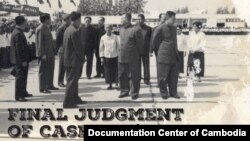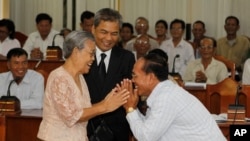A Cambodian genocide documentation center has received $6 million in support from the U.S. government, the group has said.
In a statement on Sunday, the Documentation Center of Cambodia (DC-Cam) said the $6 million in additional funding from the U.S. Agency for International Development (USAID) would be paid into an endowment fund that would accrue interest over the next 20 years, eventually bringing in some $20 million to the organization.
“The $20 million will allow us to continue our research and education about the Cambodian genocide. It can sustain at least 20 years. Therefore, it will ensure that the issue of Khmer Rouge will continue for discussion in the next generation,” Youk Chhang, DC-Cam’s director, told VOA Khmer on Sunday.
Polly Dunford, USAID’s Cambodia mission director, said the new contributions “will help put DC-Cam on the pathway to sustainability”.
“We are proud to support DC-Cam’s efforts to create a brighter future by teaching young people about the value of learning history, preserving their culture, and promoting and protecting human rights,” she said in a statement.
The United States has also paid $27 million to the international side of the Khmer Rouge tribunal since 2006.
Launched in 1995, DC-Cam has become a well-respected voice for Khmer Rouge victims and survivors.
“DC Cam has always been conservative and strategic in spending. When we started the center in 1995, we spent $25 per month for research,” said Chhang.
He hopes the new money will go towards paying for promoting human rights, democracy and the rule of law.
Latt Ky, a court monitor with local rights group Adhoc, said DC-Cam’s work was vital for Cambodians to understand their history.
“It’s necessary to strengthen and support more education since [DC-Cam] has a strategy to educate young Cambodians to understand their past clearly and help understand what happened,” he said.
Phay Siphan, government spokesman, praised the United States’ “generosity,” adding that the government will establish a legal documentation center as a “repository” of data about the regime.
Dim Sovannarom, a Khmer Rouge tribunal spokesman, said he hoped the contributions of DC-Cam to the court’s work would continue.
“I think the funding to DC-Cam is good in that it contributes to protecting and compiling documents related to the Khmer Rouge for the next generation,” he said.
DC-Cam has also recently launched a new interactive website, khmerrougehistory.org, where it hosts more than 1 million publicly accessible documents related to the regime.
“I encourage every Cambodian to talk and learn about Khmer Rouge history ... it will contribute to your truth, justice and memory of those who died brutally and all of us who have survived and lived on. It will also contribute to the prevention of such mass atrocities happening again, so that our children can live a better life and future,” Youk said.








